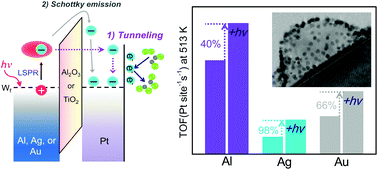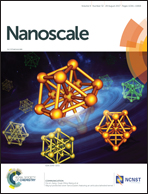Hot plasmonic electron-driven catalytic reactions on patterned metal–insulator–metal nanostructures†
Abstract
The smart design of plasmonic nanostructures offers a unique capability for the efficient conversion of solar energy into chemical energy by strong interactions with resonant photons through the excitation of surface plasmon resonance, which increases the prospect of using sunlight in environmental and energy applications. Here, we show that the catalytic activity of CO oxidation can be tuned by using new model systems: two-dimensional (2D) arrays of metal–insulator–metal (MIM) plasmonic nanoislands designed to efficiently shuttle hot plasmonic electrons. Hot plasmonic electrons are generated upon the absorption of photons on noble metals, followed by the injection of these hot electrons into the Pt nanoparticles through tunneling or Schottky emission mechanisms, depending on the energy of the hot electrons. We found that these MIM nanostructures exhibit higher catalytic activity (i.e. by 40–110%) under light irradiation, revealing a significant impact on the catalytic activity for CO oxidation. The thickness dependence of the enhancement of catalytic activity on the oxide layers is consistent with the tunneling mechanism of hot electron flows. The results imply that surface plasmon-induced hot electron flows by light absorption significantly influence the catalytic activity of CO oxidation.



 Please wait while we load your content...
Please wait while we load your content...